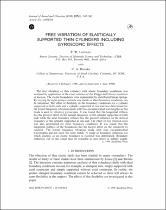 ResearchSpace
ResearchSpace
Free vibration of elastically supported thin cylinders including gyroscopic effects
JavaScript is disabled for your browser. Some features of this site may not work without it.
- ResearchSpace
- →
- Research Publications/Outputs
- →
- Journal Articles
- →
- View Item
| dc.contributor.author |
Loveday, Philip W

|
en_US |
| dc.contributor.author |
Rogers, CA

|
en_US |
| dc.date.accessioned | 2007-02-08T07:52:35Z | en_US |
| dc.date.accessioned | 2007-06-07T10:03:57Z | |
| dc.date.available | 2007-02-08T07:52:35Z | en_US |
| dc.date.available | 2007-06-07T10:03:57Z | |
| dc.date.copyright | en_US | |
| dc.date.issued | 1998-10-29 | en_US |
| dc.identifier.citation | Loveday, PW and Rogers, CA. 1998. Free vibration of elastically supported thin cylinders including gyroscopic effects. Journal of Sound and Vibration, vol 217(3), pp 547-562 | en_US |
| dc.identifier.issn | 0022-460X | en_US |
| dc.identifier.uri | http://hdl.handle.net/10204/1654 | en_US |
| dc.identifier.uri | http://hdl.handle.net/10204/1654 | |
| dc.identifier.uri | https://www.sciencedirect.com/science/article/pii/S0022460X98917655 | |
| dc.identifier.uri | https://doi.org/10.1006/jsvi.1998.1765 | |
| dc.description.abstract | The free vibration of thin cylinders with elastic boundary conditions was analysed by application of the exact solution of the Flugge shell theory equations of motion. The elastic boundaries were represented by distributed linear springs. By varying the eight spring constants any elastic or ideal boundary conditions can be simulated. The effect of flexibility in the boundary conditions for a cylinder supported at both ends and a cylinder supported at one end was determined for the lowest frequency vibration mode with two circumferential wavelengths as this mode is used in vibratory gyroscopes. It was found that the tangential stiffness has the greatest effect on the natural frequency of the cylinder supported at both ends while the axial boundary stiffness has the greatest influence on the natural frequency of the cylinder supported at one end. The effect of low rotation rates was also determined for these boundary conditions. It was found that the tangential stiffness of the boundaries has the largest effect on the sensitivity to rotation. The lowest frequency vibration mode with four circumferential wavelengths did not show the same trends A range of boundary stiffness for which analysis as an elastic boundary is essential was determine. Boundary stiffness out of this range may be regarded as zero (free) or infinite (rigid). | en_US |
| dc.format.extent | 228997 bytes | en_US |
| dc.format.mimetype | application/pdf | en_US |
| dc.language.iso | en | en_US |
| dc.publisher | Academic Press Ltd | en_US |
| dc.rights | Copyright: 1998 Academic Press Ltd | en_US |
| dc.source | en_US | |
| dc.subject | Vibration of elastically supported cylinders | en_US |
| dc.subject | Flugge shell theory | en_US |
| dc.subject | Vibratory gyroscopics | en_US |
| dc.subject | Motion equations | en_US |
| dc.subject | Boundary conditions equations | en_US |
| dc.subject | Mechanic engineering | en_US |
| dc.subject | Sciences | en_US |
| dc.title | Free vibration of elastically supported thin cylinders including gyroscopic effects | en_US |
| dc.type | Article | en_US |
| dc.identifier.apacitation | Loveday, P. W., & Rogers, C. (1998). Free vibration of elastically supported thin cylinders including gyroscopic effects. http://hdl.handle.net/10204/1654 | en_ZA |
| dc.identifier.chicagocitation | Loveday, Philip W, and CA Rogers "Free vibration of elastically supported thin cylinders including gyroscopic effects." (1998) http://hdl.handle.net/10204/1654 | en_ZA |
| dc.identifier.vancouvercitation | Loveday PW, Rogers C. Free vibration of elastically supported thin cylinders including gyroscopic effects. 1998; http://hdl.handle.net/10204/1654. | en_ZA |
| dc.identifier.ris | TY - Article AU - Loveday, Philip W AU - Rogers, CA AB - The free vibration of thin cylinders with elastic boundary conditions was analysed by application of the exact solution of the Flugge shell theory equations of motion. The elastic boundaries were represented by distributed linear springs. By varying the eight spring constants any elastic or ideal boundary conditions can be simulated. The effect of flexibility in the boundary conditions for a cylinder supported at both ends and a cylinder supported at one end was determined for the lowest frequency vibration mode with two circumferential wavelengths as this mode is used in vibratory gyroscopes. It was found that the tangential stiffness has the greatest effect on the natural frequency of the cylinder supported at both ends while the axial boundary stiffness has the greatest influence on the natural frequency of the cylinder supported at one end. The effect of low rotation rates was also determined for these boundary conditions. It was found that the tangential stiffness of the boundaries has the largest effect on the sensitivity to rotation. The lowest frequency vibration mode with four circumferential wavelengths did not show the same trends A range of boundary stiffness for which analysis as an elastic boundary is essential was determine. Boundary stiffness out of this range may be regarded as zero (free) or infinite (rigid). DA - 1998-10-29 DB - ResearchSpace DP - CSIR KW - Vibration of elastically supported cylinders KW - Flugge shell theory KW - Vibratory gyroscopics KW - Motion equations KW - Boundary conditions equations KW - Mechanic engineering KW - Sciences LK - https://researchspace.csir.co.za PY - 1998 SM - 0022-460X T1 - Free vibration of elastically supported thin cylinders including gyroscopic effects TI - Free vibration of elastically supported thin cylinders including gyroscopic effects UR - http://hdl.handle.net/10204/1654 ER - | en_ZA |





